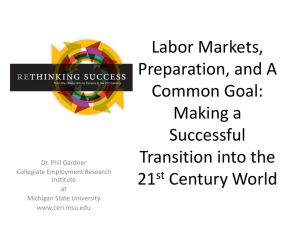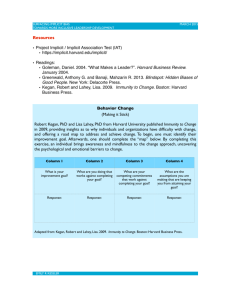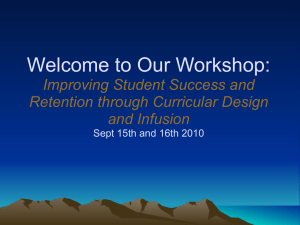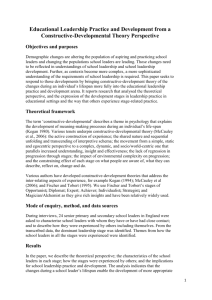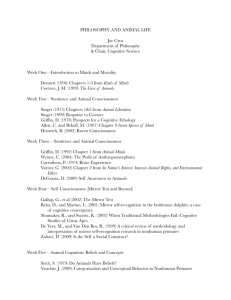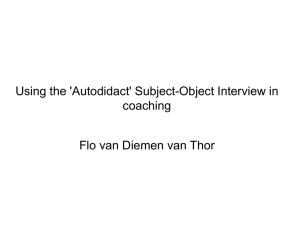Community as Curriculum
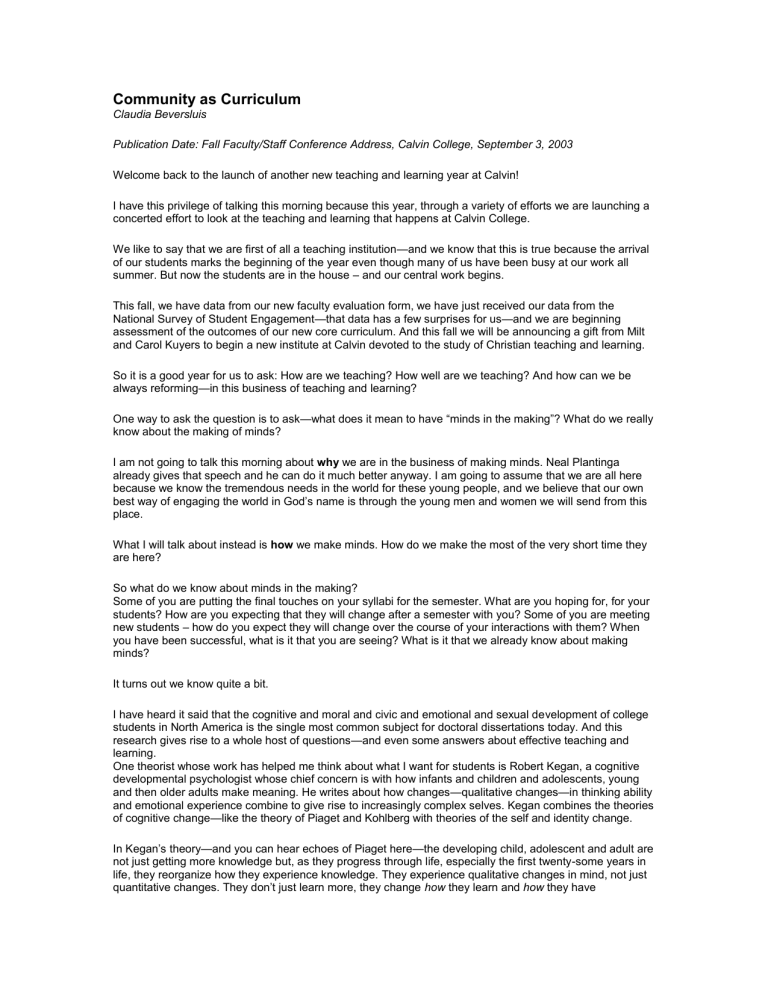
Community as Curriculum
Claudia Beversluis
Publication Date: Fall Faculty/Staff Conference Address, Calvin College, September 3, 2003
Welcome back to the launch of another new teaching and learning year at Calvin!
I have this privilege of talking this morning because this year, through a variety of efforts we are launching a concerted effort to look at the teaching and learning that happens at Calvin College.
We like to say that we are first of all a teaching institution —and we know that this is true because the arrival of our students marks the beginning of the year even though many of us have been busy at our work all summer. But now the students are in the house – and our central work begins.
This fall, we have data from our new faculty evaluation form, we have just received our data from the
National Survey of Student Engagement —that data has a few surprises for us—and we are beginning assessment of the outcomes of our new core curriculum. And this fall we will be announcing a gift from Milt and Carol Kuyers to begin a new institute at Calvin devoted to the study of Christian teaching and learning.
So it is a good year for us to ask: How are we teaching? How well are we teaching? And how can we be always reforming —in this business of teaching and learning?
One way to ask the question is to ask
—what does it mean to have “minds in the making”? What do we really know about the making of minds?
I am not going to talk this morning about why we are in the business of making minds. Neal Plantinga already gives that speech and he can do it much better anyway. I am going to assume that we are all here because we know the tremendous needs in the world for these young people, and we believe that our own best way of engaging the world in God’s name is through the young men and women we will send from this place.
What I will talk about instead is how we make minds. How do we make the most of the very short time they are here?
So what do we know about minds in the making?
Some of you are putting the final touches on your syllabi for the semester. What are you hoping for, for your students? How are you expecting that they will change after a semester with you? Some of you are meeting new students – how do you expect they will change over the course of your interactions with them? When you have been successful, what is it that you are seeing? What is it that we already know about making minds?
It turns out we know quite a bit.
I have heard it said that the cognitive and moral and civic and emotional and sexual development of college students in North America is the single most common subject for doctoral dissertations today. And this research gives rise to a whole host of questions
—and even some answers about effective teaching and learning.
One theorist whose work has helped me think about what I want for students is Robert Kegan, a cognitive developmental psychologist whose chief concern is with how infants and children and adolescents, young and then older adults make meaning. He writes about how changes
—qualitative changes—in thinking ability and emotional experience combine to give rise to increasingly complex selves. Kegan combines the theories of cognitive change —like the theory of Piaget and Kohlberg with theories of the self and identity change.
In Kegan’s theory—and you can hear echoes of Piaget here—the developing child, adolescent and adult are not just getting more knowledge but, as they progress through life, especially the first twenty-some years in life, they reorganize how they experience knowledge. They experience qualitative changes in mind, not just quantitative changes. They don’t just learn more, they change how they learn and how they have
knowledge. There is a constant movement from being something, to having something
—from experiencing something implicitly to having something explicitly .
So, for example, the infant moves from being sensation or being embedded in sensation, to experiencing a self that has sensations. The child moves from being her or his desires and concrete actions in the world, to being a self that has desires and actions. The adolescent, we hope, when she or he develops the capacity for abstract thought, moves from being embedded in values, ideals, and beliefs, to having the capacity to reflect on values, ideals, and beliefs.
And the young adult, the student in front of us in class, or beside us at work, or next to us in chapel, the young adult moves from being defined by context and systems of knowledge to reflecting on and owning oneself as a knower
—standing a bit back from the systems of thought that have shaped the past, and experiencing a new self that can serve as a shaper of the future.
Kegan is not alone in higher education when he describes this fundamental reorienting that takes place in college students during the course of their development. Other writers describe it as giving birth to a new self, as learning selfauthorship, as finding one’s own voice, as decentering and recentering, as undergoing disconnection and, it is hoped, recommitment.
There is a central movement that we want for our students
– a movement from being shaped into owning the shaping process. A movement from getting the answers right to asking the big questions, from getting more information to making knowledge together.
There are several implic ations of Kegan’s theory that especially fit our developmental task here at Calvin.
Kegan acknowledges that the movement from one meaning making level to the next
—what he calls orders of consciousness or awareness is full of resistance and risk.
This is a disorienting movement, and it can be a lonely movement. As ways of knowing change, the self moves from being embedded to taking ownership, from a reliance on implicit knowing to explicit awareness.
For those with a vested interest in the system and context that young adults are examining —and that includes the young adult herself
—the movement is a risky one. When students expand their consciousness, they can be filled with doubt about what they are beginning to examine. As the implicit becomes explicit, as instincts give way to questions….you can say, “hey, I don’t choose to claim that anymore,” or “no, that is not who I am after all.”
Kegan tells us what we already know
—teaching is, should be—dangerous, learning is full of risk for the learner. One of the most direct warnings in the Bible is for teachers. James says: Not many of you should become teachers —they will be judged more strictly.
A second thing that we can take from Kegan is his insistence on understanding the cognitive, awareness demands of this new level of consciousness. This movement into awareness of oneself as a knower is based on increasing cognitive complexity . He acknowledges many ways of knowing, but insists that explicit reflection is crucial for emerging into the kind of awareness that we are hoping for from our students.
How do we move students into a new level of consciousness?
What has expanded in the past decades and what fuels a teaching and learning industry today, is our awareness of how these changes in consciousness, changes in cognitive complexity actually happen? As we have studied the formative power of story, and art, and metaphor and ritual, as we have learned more about implicit memory and procedural memory and whole-body contributions to mindfulness, we no longer rely on only outlinable, propositional content —the kind that made us seem so organized to our students—to move students into complexity.
We have moved from a focus on proposition to a focus on practice, from abstract knowing to embodied knowing, from an emphasis on hearing the word to an emphasis on active engagement.
We have learned that we cannot just “open head, pour in deep thought”—cognitive complexity is built on active engagement. New approaches to teaching and learning involve doing and wrestling, they will foster active engagement with ideas, with people from the past and the present, with city and countries and ideas far different than ours.
We have learned that we have to build up good instincts, good habits, and fill the emerging selves of our students with internalized characters from the past and from around the world. And yet…and yet, we must guard against our tendency to merely make this college experience simply a resocialization experience, as important as that is. Kegan insists that movement into a new level of consciousness is built on awareness, an ability to stand back and ask
– why are we doing this – making the implicit explicit.
We are not
—we often say to each other—not a credentialing agency—we want a deeper education that the accreditors are asking for; not a training academy —we are educating for life; not a tour company—we insist that students reflect on their encounters with the other; not just a safe way to transition between parents to living on their own —we want them to understand their pasts and shape their futures; not a character camp— we want them to both live and study virtue; we don’t provide just a technological buffet, or an entertainment opportunity or a worship experience —we want students to seriously examine how these things shape their lives. We are not a social service agency
—we want our students to ask deep questions about justice. We are not just training instincts, building implicit but unexamined knowledge —though these are part of what we are doing. Rather, there is a certain movement we are looking for, a movement into awareness and reflection and ownership and authorship.
We must, in all we do, stress reflection, mindfulness, moving on to a new level, not just of habit, but of awareness. Another way to say this is that we must be about the business of making minds, and integrating mindfulness with the work of the heart and the hand.
So here is what I think is the fundamental question of teaching and learning here at Calvin College —
It is not about learning in small groups, about getting our students into Burton Heights or Baxter, or about whether to present material in PowerPoint or through KnightVision discussion boards
—or with chalk and blackboard.
It is not about whether the most learning takes place in the classroom or the coffee kitchen…although all of these things are all important to look at…
The central question is this:
How do we move students into greater self authorship, and still help them know the supreme author of their life?
How do we move students into the decentering process, and still keep them connected to the center of the universe?
How do we disorient, and still help students know who they are?
How do we help students integrate the head and the heart and the hand
—their thinking and heart direction and active lives of service, even when it feels like these are going in opposing directions?
How do we dare go beyond just good practices and good habits, and encourage active, critical reflection on those habits and practices?
How do we liberate through the liberal arts, and yet keep them firmly tied to the one who is our only comfort in life and in death?
How do we set students free to choose, and pray that they choose what we have chosen?
That was really several questions, but they are all, at root, the same question.
And here is my answer, in two words: very carefully.
And here are two more words: in community.
Teaching and learning that takes place in a genuine academic, mind-full community is the kind of teaching that works to integrate the implicit and the explicit, that works on multiple levels and multiple ways to move students into fuller awareness and fuller commitment, that works to prepare minds and hearts and hands to engage God’s world.
Some of us are wary of the rhetoric of community. Sometimes community language feels too much like coercion or conformity language. We have gone through our own consciousness revolution, and it has been liberating. Many writers about higher education have observed that the academic culture —the faculty side of the street at least
—selects for individualism and introversion, alienation and competition. Community just doesn’t fit how we like to work. We need our days blocked out for our own work.
Sometimes community language sounds like let’s just be nice to each other language. Some of us are wary because we long for community and haven’t seen it as fully as we had hoped, or we think this college is way too large, and community talk either disappoints or sounds hopelessly romantic.
There are many reasons that community making is an important issue for Christians and for Christian colleges, reasons I won’t go into here. What I want to convince you of this morning, is that community making here at Calvin is a teaching and learning issue, a mindfulness issue, and it is our primary answer to our dilemma of how to push students into greater mindfulness and still hold on to their hearts.
Kegan suggests that the way to move students into greater development, and thus better prepare them for the demands of their adult lives is to create a deliberate, intentional bridging community which features mentors and models for the journey. We need to think of our community as curriculum for our students because what we are asking them to do is more complex than we realize.
Kegan’s emphasis on cognitive complexity fits us so well, I think, partly because the reformed perspective, and its take on our scholarly work, is inherently cognitively complex. We are taking students who badly want
“yes or no” answers and giving them our famous “yes…but,” taking students who want things in terms of black and white, and giving them shades of gray. We want them to love what they study, but work to renew it, fully engage the world, but ask serious questions about it.
Genuine understanding and ownership of our scholarly and life-shaping project calls for sophisticated cognitive abilities. Kegan says this:
The mismatch between external epistemological demand and internal epistemological capacity is characteristic of some portion of every person’s adolescence. Is it necessarily a bad thing for the mental demands of one’s environment to outstrip the present state of one’s mental equipment? …if I were asked to...summarize my reading of centuries of wise reflection on what is required of an environment for it to facilitate the growth of its members, I would say this: people grow best where they continuously experience an ingenious blend of support and challenge: the rest is commentary.
…Environments that are weighted too heavily in the direction of challenge without adequate support are toxic; they promote defensiveness and constriction. Those weighted too heavily toward support without adequate challenge are ultimately boring – they promote devitalization (1994, pp 41-42).
The movement into a desired level of selfhood, of cognitive complexity is best done in a deliberate bridging environment. The leaders of such an environment —that’s us—work hard to understand the developmental demands of the environment, and then they provide tasks that contain both affirmation and challenge, with guides eager to share of themselves and point the way.
Kegan warns us against two dangers: On the one hand, Kegan warns against simply substituting one kind of socializing for another —one set of unexamined habits and instincts and practices for another.
He cautions against those who
…romanticize “the community” and inadequately attend to the hazards, the dangers, and even the horror potentially attendant to the processes of socialization from which one cannot stand apart. Education as socialization into a discourse community may be fitting for the student’s lower level consciousness but it may also leave the student with no greater capacity to resist induction in the future into communities of discourse….It may amount to an education for inauthenticity, since one learns the right moves and the right words but accomplishes no “inside out” mastery….Socialization into a discourse community might be the fanciest version yet of substituting training for education and changes in learning for changes in knowing
(1994, p. 289).
But Kegan warns just as strongly against assuming that students have capacity for the kinds of meaning making that we desire and he warns against teaching to our own interests and areas of questioning and growth rather than understanding the students’ abilities and questions.
We are trying to figure this out right now
—aren’t we—as we try to help students understand and own the reformed project in education? On the one hand we are wary of seeming to just give students the right formulas, the vocabulary words that will lead to right answers on the test. We cringe when we hear students talking about CFRPM (creation, fall, redemption per minute)…
On the other hand we are confused when our students seem lost, or resistant, o r when they just don’t “get it.” We have cringed—when we realized that our students were not understanding the reformed perspective even though this place was steeped in it.
Our temptation is to teach to ourselves or to our latest area of consciousness development, without understanding the cognitive and identity demands of our individual projects. We are tempted to design courses or a curriculum around our own intriguing questions and not consider our students need for support and challenge.
We turn cynical when our students long to see more obvious faith in us
—through say, devotions and prayer or worship involvement, or when our students beg to know how we ourselves have come to a faith shaped answer on a challenging intellectual question —but our cynicism may be due to our own failure to understand the complex mental demands of our mind-making project. We might be leaving our students without a well anchored bridge to an integrated future.
There is intriguing research that shows that students who have to work hard to understand and integrate two cultures
—for example North American minority students in a majority culture school—these students have a head start in developing cognitive complexity and higher orders of mindfulness – especially when they are mentored into an understanding of these two cultures by a caring community that models the mindfulness that it is trying to teach . I think we can extend these findings to our own students, students trying to navigate between a minority Christian culture and a very secular mainstream culture, trying to live out the Reformed
Project of being in the world and not of the world.
We have such huge and wonderful goals for our students as we prepare them to engage in God’s world. We need to think even more intentionally, developmentally, and collaboratively about the kind of teaching and learning that helps students navigate the complexities of this engagement. Part of our conversation should be about how we can work together across the curriculum —both the curriculum in the catalogue and the curriculum of everyday life.
We have talked about writing as a progressive skill, and developed a plan of writing across the curriculum.
What if we thought together about restlessness across the curriculum, taking initiative across the curriculum, cross-cultural competency across the curriculum, risktaking across the curriculum? How about “profound dissatisfaction with the way the world is” across the curriculum, or gender wholeness across the curriculum, or “taking a loud stand against racism” across the curriculum?
I am not talking about lock step curricular planning and compliance here, but I am pleading on behalf of more conversation and collaboration on our educational project, on behalf of the dreams and hopes for the core, for a broader imagination and deeper vision of what we are asking from and supporting for our students. Although I didn’t intend this talk to be a plea for assessment, that is what assessment is for—it is a way for us to find out what is working and what is not —and how we can plan and dream …outside of the space of our own individual classrooms.
We need to continue making an intellectual, mind making community amongst ourselves, a community that embodies integration between heart and hand and mind, so that we have something vital and lively that students desire to be apprenticed into.
I don’t usually like generalizations about generations of students, but here is one that I think we can safely make —for this generation of students, issues of belonging and acceptability and group membership are central to their quest for identity. They hunger for collaborate activity. If all of the other things that give their life meaning —activities of the heart and of the hand—if they are all social and collaborative, and if we present only models of solitary scholarship, lone-ranger thought, then it is no wonder that the life of the mind looks less than appealing.
If we fail to integrate head and heart and hand within our own lives together, something will lose out.
Perhaps for previous generations of students, the risk was that getting the thinking right didn’t translate well into heart knowledge or active engagement. But for this generation of students, I predict that the life of scholarship may feel increasingly irrelevant to a more collaborative, active life, and we will lose the reason for having a Calvin College.
If we want the work of heart and hand informed by scholarship, heart involvement linked to head work, then we need to model it in our life together.
What if academic departments talked together about the central intellectual conversations that are needed, in their arena right now, and then worked collaboratively to contribute to those conversations? What if departments gathered to dream big dreams about their own collective vocation —the place where the world’s need and our mutual deep gladness meets
—what if they thought vocationally in concert together? What if we were asked at the time of reappointment
—who are you actively mentoring into deeper reflection, into engagement with your area of the world? How are you preparing your replacements? Whose success can you take some silent delight in? What ideas have you given away? What ideas are you wrestling with right now? How have you reached out into this community to talk and act them through? How are you feeding lively conversations across the hall, across departments, across divisions? How are we nurturing each other past our own blind spots and into a fuller grasp of God’s world? This isn’t a romantic ideal of community— this is living into what we say we believe —this is creating knowledge together.
We are doing wonderful collaborative work here. But let’s do it even more deliberately, more intentionally, and in a way that focuses on apprenticing students into an in tegrated life. Let’s do it as if the health of our integrating project depends on actively preparing those who come after us.
And finally, as a community, we have something to say to the field of higher education about the practice of higher education —and the something that we have to say is community . There is a revolution of sorts going on in higher education
—a focus on service and spirituality, on character and moral formation, and we could and should be thought of as an important resource in that revolution. There are actually many educators asking roughly the same kinds of question about teaching and learning that we asked a few minutes ago
— how do we liberate students with the liberal arts and still keep them connected to the common good? How do we educate the mind in ways that bring the heart and hand along?
One answer is that it can’t be done. Here is what George Kuh, the primary force behind the NSSE – says about the character building power of Christian colleges:
The most influential institutions —those most likely to have distinctive imprints on their students – have a powerful, conforming campus culture. But such cultures almost always have side effects, one of which may be blunted intellectual and spiritual development (e.g. students who arrive at c ollege with a “foreclosed” view of their faith and are not challenged to examine this view)…Recall the lower gains reported by CCCU students in the intellectual and academic area. What is the appropriate balance between emphasizing character development and intellectual development? Are they mutually exclusive? (Kuh, 2002).
We don’t think they are mutually exclusive—and we don’t even think they are in tension. We think they are consistent parts of a fully orbed, fully engaged life. We think it can be done...we think we are doing it.
We are delighted when we influence the conversations in philosophy by our scholarship in philosophy, the work in sociology by our scholarship in sociology, work in music by our musical excellence and scholarship.
And we have been able to influence the practice of Christian higher education by our emphasis on mindfulness our insistence on excellence in disciplinary scholarship for the glory of God.
Now it is time for us to influence the field of teaching and learning in higher education with the message that instinct and metaphor, art and examination, head and heart and hand, proposition and practice
—all can be devoted to the same mission in a unique and effective learning environment. And what we can offer is this notion of a community whose heart and mind and hand are all part of the same body. Here is a sentence from our own Expanded Statement of Mission:
Christian education at the college level needs to be seen as a dynamic process in which all of us continually try to get our deepest commitments, educational activities, and life practices headed in the same direction
(ESM, p. 34).
In order to influence the higher education conversation, we need to make our own implicit practices explicit, we need to write and test, and assess and research, and show just what it is that we are dedicated to here
— and we need to show that it works. On the national and international stage, this is called the scholarship of teaching and we could and should be in the center of it.
In many very important ways, the community and communities that we are able to make together over this next year are the curriculum
—for our students, for ourselves, and, if we choose, for the world of higher education. And we have this promise —We can go forward into this year, mind, heart, and hand together in one body, dedicated to the same mission, with the confidence that where two or three (or four or five thousand) are gathered, God is in our midst.
May God bless us in this new year.
Calvin College. (1996). Expanded statement of mission: Vision, purpose, commitments.
Grand Rapids, MI:
Calvin College.
Kegan, Robert. (1994). In over our heads: The mental demands of modern life.
Cambridge, MA: Harvard
University Press.
Kuh, George. (2002). Do environments matter? A comparative analysis of the impress of different types of colleges and universities on character.
Journal of College and Character.
http://www.collegevalues.org.
